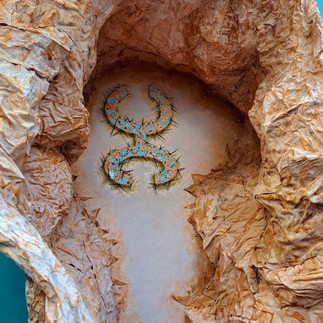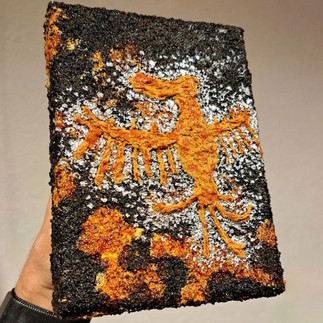Speaking through Spices: An Artist Unlocking Ancestral Memory
- Twin Island Cinema
- Apr 7, 2024
- 2 min read
Exploring Ancestral Memory through Art: A Studio Visit with Justin Reinir Croes
In the pursuit of understanding the intricate relationship between indigenous heritage, artistic expression, and the preservation of ancestral memory, my recent visit to the studio of Justin Reinir Croes was a journey filled with Caribbean warmth, familiarity and artistic exploration. Justin, an Aruban multidisciplinary artist, graciously welcomed me into his creative space, located in s-Hertenbosch, Netherlands to connect, share and discuss his ongoing project 'RUCU', which intricately explores the reconnection of his indigenous ancestry through the ritualistic use of the Anatto seed, also known as Rucu or achiote.

Justin's studio was a testament to the fusion of tradition and innovation, adorned with a diverse array of paintings, sculptures, and installations that immediately captured my attention. As I entered the space, Justin greeted me warmly, and in true Caribbean style, had a spread of sandwiches and fruits for us to eat together. Our dialogue unfolded into an enlightening discourse on the profound connection that artistic expression has on accessing and regenerating shared ancestral memory.
"This project called 'RUCU' serves as an embodiment of my quest to reconnect with my indigenous roots and two-spirited identity through a ritual that engages various sensory modalities," Justin articulated passionately. Gesturing towards a series of artworks prominently featuring the Anatto seed, he elucidated, "The utilization of Rucu or annatto represents a profound symbolism deeply embedded within the cultural fabric of indigenous tribes across the Caribbean, South, and Central America."

Intrigued by the artistic process, I listened intently as Justin expounded on the intricate techniques employed to derive gradients of pigment, scents, and colorations from the Anatto seed. He underscored the nuanced reactions of this sacred substance to sunlight and diverse mixing methodologies, illuminating the layers of meaning and ancestral connections imbued within each artistic creation.
As an academic researcher with a vested interest in the spatial organization of indigenous cultures, Justin's work resonated profoundly with my scholarly inquiry into the preservation and transmission of ancestral knowledge. Our conversation traversed diverse facets of indigenous culture, from burial customs involving clay pots to the evolution of language, mythology, and gender relations. Through his art, Justin epitomized a profound reverence for heritage and a commitment to disseminating these narratives to a broader audience.

Reflecting on our scholarly exchange, I am struck by the transformative potential of indigenous spatial practices within contemporary human community and industry design, particularly within the burgeoning domain of digital culture. Justin's creative endeavors serve as a compelling case study in bridging traditional wisdom with contemporary innovation, underscoring the enduring relevance of ancestral memory in shaping cultural identities and artistic expressions.
I encourage fellow academics, researchers, and aficionados of indigenous studies to delve deeper into Justin Reinir Croes' artistic oeuvre through his website and Instagram. Engage with his vibrant creations, delve into the narratives of ancestral memory, and contribute to the scholarly discourse surrounding the intersection of heritage, art, and identity. Let us continue to celebrate and interrogate the multifaceted legacies of indigenous cultures, guided by visionary artists like Justin who channel the ethos of the past into the tapestry of the present through the universal language of art.









Comments